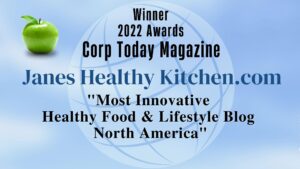A Ninja grocery shopper knows how to read labels and can see through spurious claims in fake foods. Most people in grocery stores are unaware, guided by cravings, colors, or store layout. Uh Oh! Sometimes I wonder – how did that food get in their cart? How do YOU shop? What’s your thought process as you go through a store? If you follow the store layout like most people, you’ll spend a lot more $ dollars, and get less nutrition. OR you can become a Ninja shopping warrior! Aha! Awareness is everything. Knowledge is power. Armed with clear understanding of your health goals, you’re empowered to choose the healthiest, most nutritious foods. My advice: Bring a LIST, and stick to it. Buy local organic fresh fruits and vegetables, and just skip the packaged foods altogether. Ha Ha!
Learn how to become a Ninja shopping warrior!
Grocery layout is a studied science, designed to make you buy specific brands. Shelf order is a psychological trap, with the most expensive foods conveniently at eye level, and generic brands on the lower shelves so you have to crouch. Foods meant to appeal to kids are always at kids’-eye-level, with cartoon characters for easy eye contact with quick passers-by.
End caps are shopper traps for impulse buying. Food companies pay higher prices to display their products there. Researchers say a product on an end cap sells 8X faster than the same product elsewhere in the store! And shopping carts have been growing! According to experts, doubling the size of the shopping cart leads shoppers to buy 40% more!
Be a Ninja Shopping Warrior.
On the other hand, Ninja shopping warriors are smart, one pointed, and they’re difficult to distract. They go gracefully through the store armed with a list, and come out quickly with the best nutritious food. Your simple awareness of the myriad psychological distractions designed for you, makes you almost immune to their influence. Organic fresh fruits and veggies are always the #1 best nutritional value in the store. If you purchase packaged foods or animal products, these definitions can REALLY help you. Learn what the terms mean, and don’t be influenced by pretty pictures or marketing claims.
Legal Food Definitions for Ninja Shoppers:
All-Natural – The USDA requires that meat, poultry, and egg products labeled as “natural” must be minimally processed and contain no artificial ingredients. However, the “natural” label does not include any standards regarding farm practices. It only applies to processing of meat and egg products. So there are no standards or regulations for the labeling of natural food products that do not contain meat or eggs. Hah!
Antibiotic-free – This means that no antibiotics have been mixed into the animal’s drinking water, added to feed, stationed in the animal’s pen to be licked, and/or injected into the animal’s body. Organic standards disallow antibiotic use. If an animal is sick and given antibiotics, the animal and/or its products can never be sold as organic after the treatment.
Cage-Free – Often confused with “Free Range”. This doesn’t mean much. These hens are un-caged inside barns. They may or may not have any access to the outdoors. This is a voluntary certification for producers. The term does not specify feed, so you can assume it is GMO-grains.
Canola oil. 99% of canola in the US is GMO. Avoid it. Even GMO-free canola oil is generally harvested with Glyphosate. Better just forget canola oil altogether.
Cottonseed Oil – Avoid this as cotton is GMO.
Corn is best avoided. Almost all corn is GMO. This includes corn oil, muffins, corn on the cob, high fructose corn syrup, modified food starch and foods thickened with cornstarch. Vitamin C supplements as corn-based ascorbic acid can contain GMOs.
Farmed Fish – Avoid farmed fish as they are fed GMO grains. This includes farmed salmon, trout, carp, cod, turbot, halibut, shrimp and tilapia. Purchase only “wild caught” Fish.
Free Range – The USDA defines “free range” only for chickens, not for livestock. “Free range” means birds must “have access to the outdoors for an undetermined period each day”. In practice, this could mean the chickens live mostly outdoors, or it can mean the chickens live in cramped, indoor pens that have access to the outside, whether they use it or not. “Free-range” does not regulate feed, hence we can assume hens are fed GMO grains.
Gluten-Free – This means there are no glutinous grains, such as wheat, rye, barley, or spelt. However gluten-free does not necessarily mean it’s healthy. It just means this product uses different flours that could be even higher in carbs and worse for your health. That’s the reason most people gain weight after going on a gluten-free diet. Don’t fall for it. However if you’re celiac, gluten is to be carefully avoided.
GMO-free – This means the product has been made without GMO ingredients. But this does not mean it is healthy. It may have been grown with pesticides and herbicides such as Glyphosate. It may contain artificial ingredients or heavy metals. It may have been heated, pasteurized, or irradiated. Organic is a safer term to look for, since it eliminates GMO’s and most toxins.
Grain-free – A good sign in general. It means there’s no wheat, corn, oats, rye, rice, barley, or other grass-family seeds.
Grass-Fed – While the USDA still evaluates and approves grass-fed claims, effective January 2016, the government no longer has an official definition for “grass-fed”. So the phrase is open to interpretation! In general practice 100% grass-fed animals receive only fresh pasture and dried forages, like hay. They may consume supplements, but never receive GMO grains. “100% grass fed” is a term we understand but is not legally controlled. “Grass fed” is even more vague.
In general, beware of animal products fed GMO grains, such as any dairy, eggs, chicken, beef, pork, or products not labeled organic. All animals are generally fed GMO corn and soy. Look for dairy products free of rBGH (a Monsanto GMO growth hormone that artificially increases cows’ milk production). Even “rBGH-free” beef may be fed GMO grains
No Growth Hormones – Meats with this label cannot receive supplemental growth hormones or steroids at any time from birth to harvest. FDA regulations do not allow hormones in pork and poultry, so those industries do not use artificial or added hormones. Therefore, all pork and poultry is “Raised without Hormones”.
Multigrain – Usually means it contains wheat and several grains. If it is not organic, it will most likely contain GMO grains, herbicides and pesticides. Read the label and good luck!
Natural – This is a nice word with no legal meaning. “Natural” foods are not verified, which means anyone can make up their own definition. “Natural” foods can include artificial ingredients, may be genetically modified, and grown with dangerous chemicals. Pass it up.
Natural flavors, Artificial Flavors – Equally toxic, these do not have to be specified. Avoid them as they most likely contain GMO 2.0 synthetic biology flavor enhancers.
No Sugar Added – Uh Oh! A red flag. It indicates they haven’t added any sugar. However they can still add plenty of sweet ingredients like dates, raisins, and fermented or artificial sweeteners. Avoid sugar, cane sugar, cane juice, dextrose, corn syrup, fruit juice, agave, molasses, maltodextrin, fructose, glucose, or caramel color. Sugar cane and evaporated cane juice are raised with glyphosate. Avoid “SUGAR” which means GMO beet sugar.
100% Organic – Means all ingredients are certified organic.
Organic – If a product has a USDA label that says organic, then 95% or more of the ingredients must have been grown or processed without synthetic fertilizers or pesticides (plus other standards).
“Made with organic ingredients” must have a minimum of 70% all ingredients that meet the standard. However that means up to 30% could be non-organic or GMO! Now you can understand, this is why I buy unprocessed foods and cook at home.
Pasture Raised – The HFAC’s “requirement for “Pasture Raised” hens is 1000 birds per 2.5 acres, and the fields must be rotated. The hens must be outdoors year-round, with mobile or fixed housing where they can go inside at night. For beef, there is currently no legal definition for “pasture raised”, so your guess is as good as mine. In general usage, pasture-raised means animals graze certified organic pasture whenever weather permits and receive supplemental GMO grain rations. So I shop only at meat counters I trust.
Pesticide Free – Sorry! This is not a legally verified term, hence it may or may not be true. Look for a certified organic label to avoid pesticides.
Soy is GMO: Avoid all versions of soy including soybean oil, soy lecithin, soy, protein, isolate, isoflavone, tofu, tempeh, hydrolyzed vegetable protein, GMO soy sauce, and most vitamin E supplements are from soybean oil.
Serving Size – A low serving size on the label is a red flag. By law, any ingredient representing less than 0.5 grams per serving is not required to be listed. Hence smaller particles, flavorings, artificial sweeteners, nano foods, and other chemicals may not be shown. This is a huge loophole for food manufacturers. Hence a small serving size is a flag for caution. Example: sweeteners and teas.
Sugar-Free – A bad sign. Generally means there’s no cane sugar or GMO beet sugar. However it spells trouble, as it may contain plenty of sweeteners in the form of dates, fermented sweeteners, honey, or artificial sweeteners.
Sustainable, or Sustainably Raised – The USDA has no definition for holistic animal welfare, so environmental claims like “humanely raised” or “sustainably farmed” are unsubstantiated. Investigators found that few label claims approved by USDA are checked, verified or recorded.
Vegetarian Fed – Means the animal is fed plants, and absolutely no animal by-products. That’s a good indication. However the term does not tell you if its feed was free of GMO’s or Glyphosate.
Wheat – Most people are intolerant to the modern genetic version of wheat and gluten, although there are a few individual exceptions. Unless labeled organic, all wheat is harvested with toxic Glyphosate. Safe gluten free products are millet, rice, quinoa, buckwheat, amaranth, corn, and sorghum, all organic. If you’re gluten intolerant, look for gluten-free products. Avoid these glutenous grains: wheat, barley, rye, triticale, oats, spelt, kamut, faro, durum, bulgar and semolina.
Conclusion
I hope these definitions will help you become a Ninja food warrior. Final advice: Be a free-thinking, awake, and independent shopper. Make a list and stick to it. Take your own self-designed path through the store. Be aware of your food cravings. Observe your decision-making process. Try not to shop so often, as fewer and more efficient shopping trips are easier on the pocketbook. Vote by spending your money on healthy choices, knowing that the food industry is watching your every move. And NEVER shop when you’re hungry.
“Remember, a dead fish can float downstream, but it takes a live one to swim upstream.”
W.C. Fields





No Replies to "Be a Ninja Grocery Shopper!"